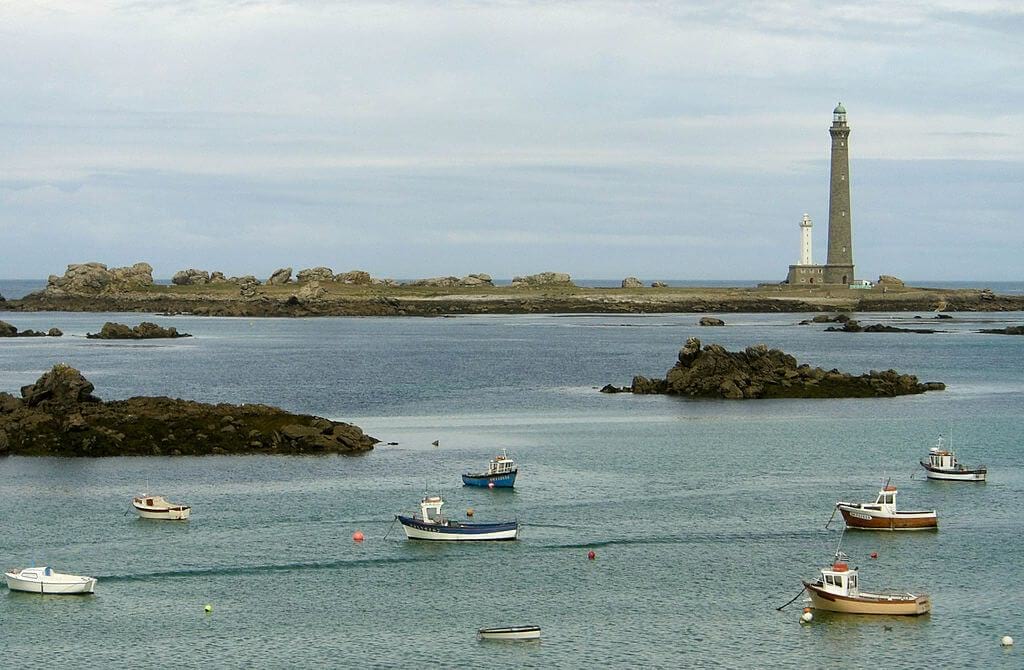The Virgin Island, Enez-Werc’h in Breton, is a small islet of 7 ha off the coast of Brittany, on the border of the English Channel and the Celtic Sea. It is located exactly 1.4 km from the tip of Kastell Ac’h, in Plouguerneau. It is today completely deserted, but includes 2 lighthouses: one built in 1845 and the other larger in 1897.
If you are not afraid of finding yourself alone on a desert island, embark for the Virgin Island, 1 hour 30 minutes from the Le Kervastard campsite in South Finistère and discover the tallest stone lighthouse in Europe!
The Virgin Island Lighthouse: History
On the Virgin Island, to the north of Finistère, stand 2 imposing monuments perceptible from afar: 2 lighthouses which watch over the open sea. The first lighthouse was built between 1842 and 1845 in cut stone and granite rubble. It is made up of a square tower 33 meters high and a 2-story base which accommodates the guards’ accommodation. With a range of 14 miles and a fixed white light, the lighthouse lacked power and became ineffective in guiding sailors, hence the interest in a new building. Today, the white tower is used as a bitter.
Between 1897 and 1902, a second lighthouse was erected to be more efficient on the lighthouse route. With a tower 82.5 m high, it is the tallest lighthouse in Europe and the 4th tallest in the world. This second building has a range of 27 miles, or 52 kilometers, and a white light that flashes every 5 seconds, in order to sweep the entire northern Finistère.
The triple-walled tower, frustoconical on the outside and cylindrical on the inside, is made entirely of Kersanton granite cut stone to resist bad weather. The interior is covered with 12,500 opaline tiles for an impeccable finish. There are no less than 397 steps to reach the summit and the lantern, including 360 suspended cut stone steps as well. The lighthouse offers breathtaking views of the entire coast and surrounding islands.
In 1956, the Virgin Island lighthouse was electrified using generators to which two wind turbines were added in 1967. The latter were dismantled in 1994. In 1983, an electric rotation machine was installed to replace the one driven by weight. In 2010, the lighthouse was automated, then remotely operated from the Créac’h lighthouse on the island of Ouessant.
The last change of guards left the island on October 20, 2010. Since then, it has been deserted. From 2021, the old lighthouse will be transformed into a lodge with a capacity of ten people to accommodate visitors and tourists looking to spend more time on the island.
If you are looking for a moment of solitude and tranquility off the coast of the Iroise Sea, stay on the Virgin Island and enjoy an unmissable panorama of the Abers country!
Since 2011, the Virgin Island site has been classified as a historic monument, as well as a Natura 2000 natural area.
The Virgin Island lighthouse: Practical information
Access :
At low tide, you can access the Virgin Island on foot. At high tide, you can either go there by renting a sea kayak or by boat.
Departing from the Port of Aber Wrac’h or the tip of Castel Ac’h Lilia Plouguerneau, the Abers speedboats provide transport to the Virgin Island. The structure even offers a guided tour of the Virgin Island lighthouse with a guide from the Abers Tourist Office. To find out more about prices and crossing times, contact the structure on 02.98.04.74.94 or visit their official website: http://www.vedettes-des-abers.com
Prices :
These are the prices for visiting the Virgin Island lighthouse excluding transport costs.
Free for under 7s.
€2 for 7 to 11 year olds, job seekers, students and people with disabilities.
€3.50 for over 12s.
€10 for a family of 2 adults and 2 children.

